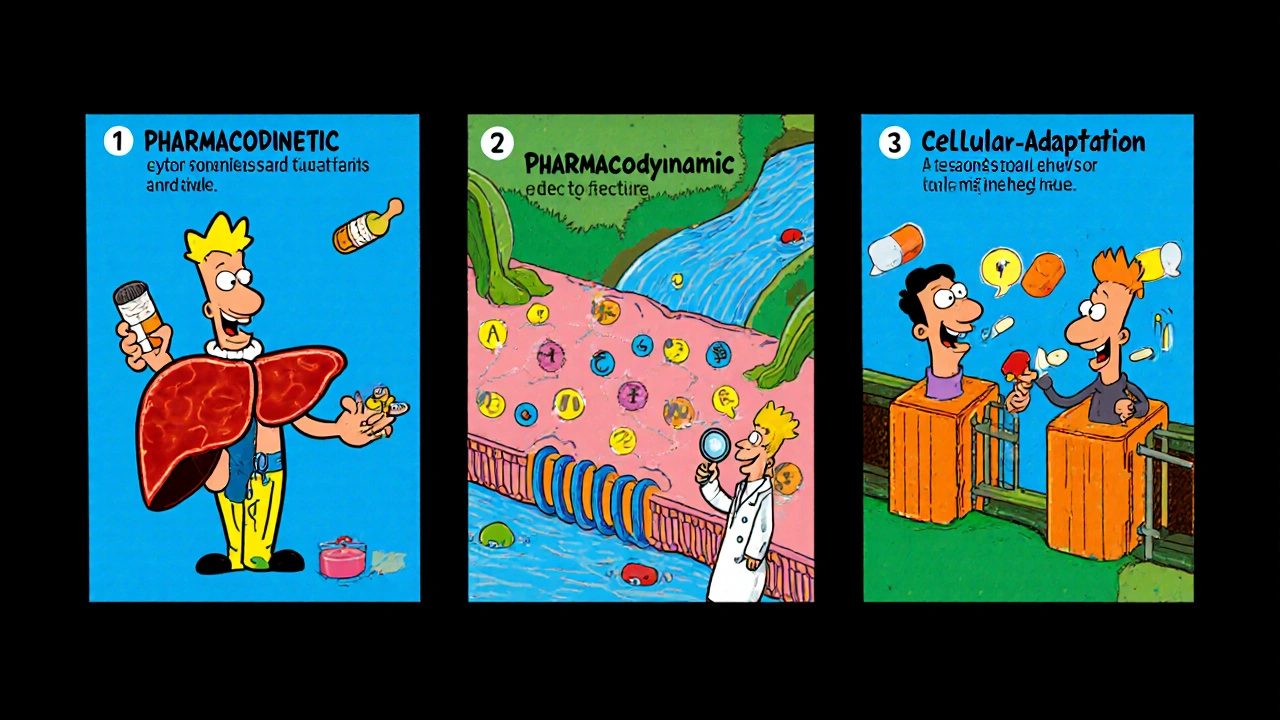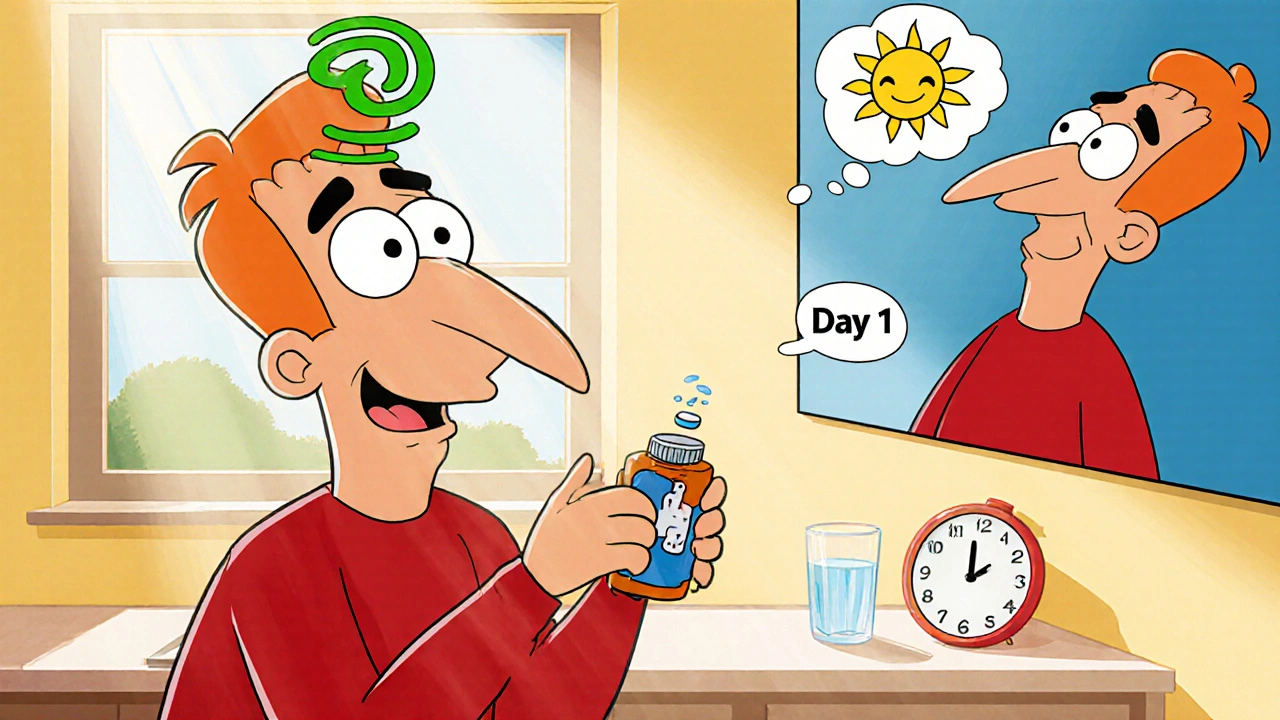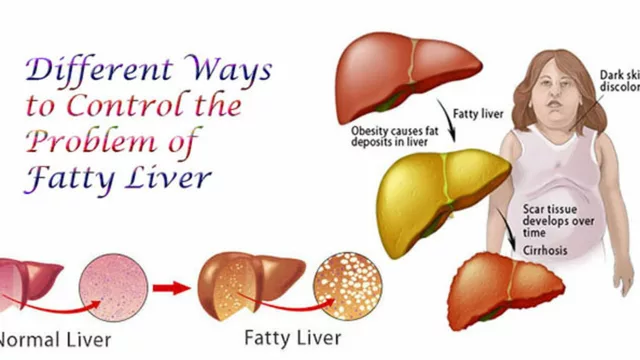Ever noticed that the nausea from a new pill disappears after a few days while the headache sticks around? That puzzling pattern isn’t random - it’s a classic case of medication tolerance. When your body learns to handle a drug, certain side effects melt away, but others may linger. Understanding why this happens can help you and your clinician manage treatment more smartly.
Key Takeaways
- Drug tolerance is a reduced response to a medication after repeated use, driven by pharmacokinetic, pharmacodynamic, and cellular‑adaptation mechanisms.
- Different side effects can fade at different speeds - a phenomenon called differential or unsympathetic tolerance.
- Opioids, benzodiazepines, antidepressants, and antihypertensives all show distinct tolerance timelines.
- Genetic factors (e.g., CYP2D6 variants) and enzyme induction (Cytochrome P‑450) explain much of the individual variability.
- Practical strategies - dose adjustments, drug holidays, and therapeutic drug monitoring - can mitigate unwanted tolerance effects.
What Is Drug Tolerance?
Drug tolerance is a pharmacological phenomenon where a patient’s response to a medication diminishes after repeated exposure, as defined by the World Health Organization and detailed in the American Society for Pharmacology and Experimental Therapeutics. Tolerance can affect both the desired therapeutic effect and the unwanted side effects, but the two don’t always change at the same rate.
Main Mechanisms Behind Tolerance
Three core mechanisms drive tolerance development:
Pharmacokinetic (Metabolic) Tolerance
Pharmacokinetic tolerance occurs when the body speeds up drug metabolism, often by inducing hepatic Cytochrome P‑450 enzymes. For example, chronic alcohol use can boost CYP2E1 activity by up to 300 %, and barbiturates up‑regulate CYP1A2, CYP2C9, CYP2C19, and CYP3A4. Faster metabolism lowers plasma concentrations, so side effects linked to peak levels (like nausea) recede.
Pharmacodynamic Tolerance
Pharmacodynamic tolerance involves cellular adaptations at the drug’s target. Receptor down‑regulation, reduced binding affinity, and altered intracellular signaling can all blunt the drug’s effect. Opioid receptor studies show a 20‑50 % drop in receptor numbers after a week of regular dosing.
Cellular‑Adaptation (Subunit‑Switch) Tolerance
Chronic exposure can also remodel the composition of ion‑channel or receptor subunits. Alcohol, for instance, raises NMDA‑receptor R2B subunit expression by 40‑60 % and reduces GABA‑A δ‑subunits by up to 50 %. These structural changes re‑balance neuronal excitability, explaining why sedation fades while some motor side effects persist.
Differential Tolerance: Why Some Side Effects Disappear Faster
Each mechanism operates on different physiological systems and on its own timeline. That’s why nausea from opioid analgesics often vanishes within 5‑7 days, yet constipation remains stubbornly steady. The term “differential tolerance” (also called “unsympathetic tolerance”) was first coined by Kalant et al. in 1971 to describe exactly this uneven adaptation.
Clinical data illustrate the point:
- Opioids: respiratory depression tolerance shows a 70‑80 % reduction within a week, while constipation stays at ~90 % of baseline (Comer et al., 2015).
- Benzodiazepines: sedative effects drop 60‑70 % after 14 days, but anxiolytic efficacy remains near 90 % (Busto et al., 1989).
- SSRIs: nausea fades for ~73 % of patients within 2‑3 weeks, yet sexual dysfunction persists in over half the cohort (NAMI, 2022).

Tolerance Patterns Across Major Drug Classes
| Drug class | Side effect that wanes quickly | Typical onset of tolerance | Side effect that persists | Persistence duration |
|---|---|---|---|---|
| Opioids | Nausea, respiratory depression | 2‑3 days | Constipation | Weeks‑months |
| Benzodiazepines | Initial sedation | 7‑14 days | Anxiolytic effect | Maintained |
| SSRIs | Nausea, dizziness | 2‑3 weeks | Sexual dysfunction | Months‑years |
| Beta‑blockers | Fatigue | 3 months | Blood‑pressure control | Maintained |
These patterns underscore that clinicians must anticipate which side effects are likely to fade and which will need proactive management.
Clinical Implications and Management Strategies
Knowing the tolerance timeline helps avoid two common pitfalls: unnecessary dose escalation and mistaking tolerance for disease progression. Here are evidence‑based tactics:
- Therapeutic drug monitoring (TDM): For drugs with narrow therapeutic windows (e.g., lithium, carbamazepine), measuring plasma levels can differentiate true tolerance from inadequate dosing.
- Proactive adjuncts: Prescribe laxatives alongside opioids from day 1 because constipation rarely shows tolerance.
- Scheduled “drug holidays”: Brief interruptions (7‑10 days) can reverse tolerance by 40‑60 % for agents like nitroglycerin (Park et al., 2018).
- Genotype‑guided prescribing: Test for CYP2D6 variants before starting codeine; poor metabolizers (7‑10 % of Caucasians) experience little analgesia and may develop atypical side‑effect patterns.
- Patient education: Explain differential tolerance so patients know which symptoms should improve and when to report persistent issues.
Patient Voices: Real‑World Evidence
Online forums and drug‑review sites consistently echo the clinical data. On Reddit’s r/ChronicPain, 78 % of 1,245 respondents said nausea from opioids vanished within a week, yet constipation lingered for the study’s entire length. A Drugs.com review of pregabalin noted dizziness resolved for 82 % of users by day 21. These anecdotes reinforce the importance of setting realistic expectations.

Future Directions: Personalizing Tolerance Management
The next wave focuses on genetics and formulation science. The NIH’s Tolerance Research Initiative (2024) is funding studies on OPRM1 and CYP2D6 variants to predict rapid opioid‑side‑effect tolerance. Meanwhile, “tolerance‑resistant” drug designs, such as polymer‑encapsulated oxycodone, have shown a 60 % reduction in respiratory‑depression tolerance over eight weeks (Phase III, NCT04567821).
Regulatory bodies are catching up. The FDA now requires new CNS‑acting drugs to list expected tolerance timelines in the prescribing information, a change adopted by 78 % of approvals since 2021. Electronic health‑record vendors like Epic have built tolerance‑trajectory algorithms that lowered inappropriate dose escalations by 34 % in a 12,000‑patient cohort (JAMIA, 2022).
Bottom Line
Side‑effect tolerance isn’t a mystery; it’s a predictable, mechanistic process. By recognizing which adverse effects are likely to fade, leveraging genetic insights, and using practical tools like drug holidays and TDM, clinicians can keep patients comfortable while preserving therapeutic benefit.
Frequently Asked Questions
What’s the difference between drug tolerance and drug dependence?
Tolerance means you need a higher dose to get the same effect, but it doesn’t necessarily mean you’re addicted. Dependence involves physiological and psychological cravings and withdrawal symptoms when the drug stops.
Can tolerance be reversed?
Yes, a short drug holiday or switching to a different formulation can roll back tolerance for many drugs, often reducing it by 40‑60 %.
Why does constipation persist with opioids?
Opioids bind to μ‑opioid receptors in the gut, which are not down‑regulated as quickly as central receptors. Hence the gastrointestinal side effect shows minimal tolerance.
Should I get genetic testing before starting antidepressants?
Testing for CYP2D6 or CYP2C19 can help predict metabolism speed for certain SSRIs and tricyclics, potentially reducing trial‑and‑error dosing.
How long does it take for sedation tolerance with benzodiazepines?
Sedation typically wanes by 60‑70 % within 7‑14 days, while anxiolytic effects stay near the original level.




